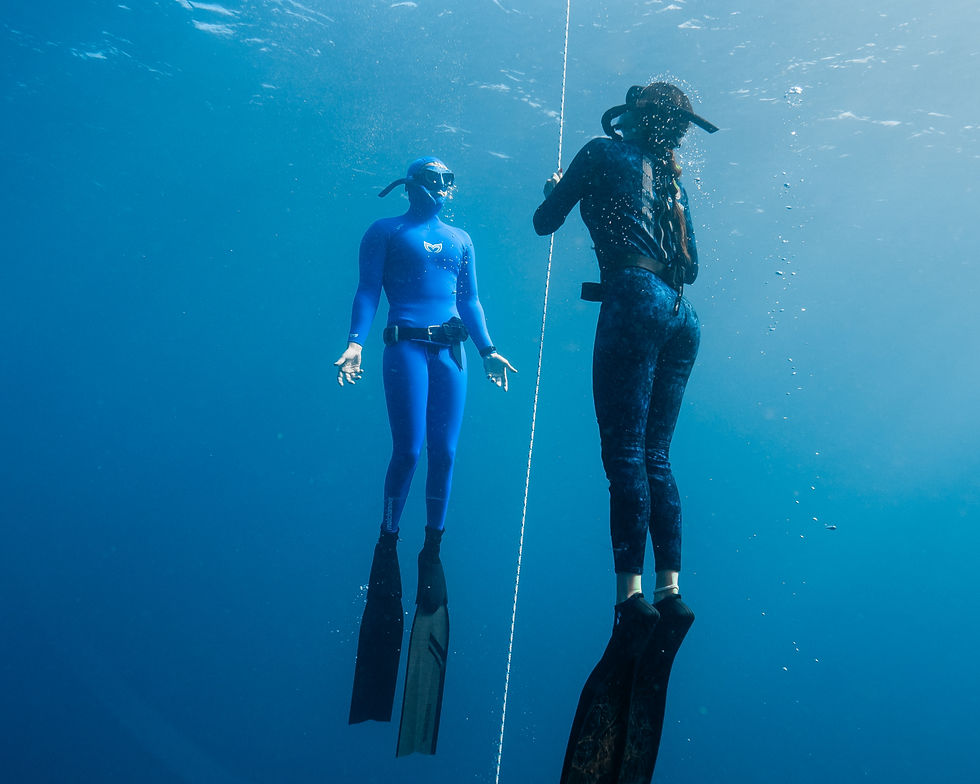The Best Freediving Mask 2026: Tested at Depth
- Curtis Tredway

- Sep 23
- 4 min read
Updated: Oct 9

Finding the perfect freediving mask is one of the most important steps in your freediving journey. It’s not about the price tag or flashy features, t’s all about the fit. The best mask for you will depend on your unique facial structure, and what works for one diver might not work for another.
At Deep Sensations Freediving, we’ve tested a wide range of masks, both on ourselves and with hundreds of students. Below, I’ll share my honest feedback on the masks that consistently perform when it comes to comfort, seal, and depth.
Why Low-Volume Masks Matter
Low-volume masks are specifically designed for freediving, offering some key advantages:
Easier Equalisation – Less air is needed to equalise, so you save energy and oxygen.
Comfort at Depth – With less internal space, pressure changes are more manageable.
Reduced Risk of Mask Squeeze – Smaller air volume helps minimise discomfort and seal loss on deeper dives.
The trade-off? You usually sacrifice a little field of view compared to scuba masks. For shallow reef dives under 10 m, some divers prefer a larger full-frame mask. But when you’re chasing depth, a low-volume mask is the way to go.
Our Top Freediving Masks for 2026
1. Molchanovs Core Mask

The Molchanovs Core remains a classic. It’s simple, reliable, and fits a wide variety of face shapes. Lightweight and low-profile, it equalises with ease and works beautifully for both depth sessions and recreational reef dives.
2. Evolve X-Dream

This mask has become one of my personal favourites. It’s ultra-low volume with a super soft silicone skirt that creates a snug seal. What impressed me most was how little air it needed to equalise. I comfortably took the X-Dream down to 35 m with almost no noticeable pressure change and barely any need to equalise—that’s rare for a mask.
3. Cressi Nano

The Nano has a loyal following, and for good reason. It’s compact, durable, and performs well even on longer dives. I’ve personally taken this mask to 50 m with no issues, finding it stayed sealed and equalised easily throughout the descent. A fantastic choice for divers who want a proven, dependable mask for both training and travel.
Check it out here
4. Omer Wolf

The Wolf is one of the more underrated masks on the market. It’s comfortable, sturdy, and sits low on the face. I tested it comfortably down to 40 m, where it handled equalisation smoothly with no major squeeze or leaks. It’s a great option if you want a solid “all-rounder” mask without the higher price tag of some competitors.
5. C4 Falcon

For those who prefer a wider field of vision without compromising on low volume, the C4 Falcon is a great pick. Its frame is feather-light, and the hypoallergenic silicone skirt sits softly on the face. This is a great mask if you split your time between depth training and recreational reef diving where you want more visibility.
Category Winners
Best Mask for Spearfishing - Omer Wolf
Best Mask for Freediving - C4 Falcon. I still find it hard to go past the C4 Falcon. It was my favourite mask last year, and it is still my go to. I have also used it for hundreds of my students and it fits most face shapes well.
BONUS: Evolve FREEQ Goggles – A Self-Equalising Option
Disclosure: Deep Sensations owner Curtis is affiliated with Evolve Apnea.
When I first heard about “self-equalising” goggles, I was sceptical. But after testing the Evolve FREEQ, I was hooked. These goggles are designed for advanced freedivers pushing beyond 40 m and offer a seamless way to transition away from a mask and to nose clip diving.
The new 'Deep Freeq' are capable of taking you to 100 m+ without wasting precious air equalising your mask. I lost my first pair in Amed and felt like I’d lost part of my dive kit, but luckily Evolve stepped in to replace them. That’s how much I rate these goggles: I would happily buy multiple sets myself if needed.
Choosing the Right Mask
No matter how many reviews you read, the single most important factor is fit. Here’s how to make sure your mask works for you:
Try Before You Buy – A proper freediving mask should seal to your face with light suction without using the strap.
Comfort Over Price – An expensive mask doesn’t guarantee a better fit. Go for what feels natural.
Match Your Goals – Reef exploring? Go for something with a wider field of view. Depth training? Opt for ultra-low volume.
A good mask for someone else, doesn't mean it's a good mask for you!
Final Thoughts
At Deep Sensations Freediving, we’ve tested and used these masks over years of courses, retreats, and personal training. Each of the masks above has been proven reliable at depth, but remember, your perfect mask is the one that fits your face.
If you’re unsure, try a few options before committing.
And if you want to test your new mask in the ocean under safe guidance, join one of our courses or retreats - you’ll get access to our gear, expert feedback, and plenty of time in the water to find what works best for you.
Disclaimer: We’re not endorsed or paid by any of these brands. These are our genuine experiences from real dives. While Curtis is a Molchanovs Ambassador and receives some products for free, all recommendations are based purely on performance and fit.
.png)


Comments